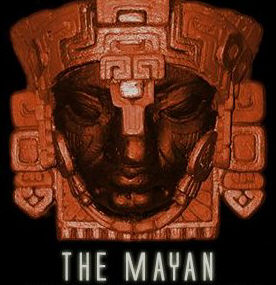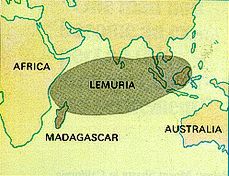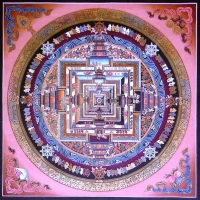 |
||
Atlantis
The hole in a bag with apples Atlantis and Lemuria - lost continents, or a dreamland of Eden?Copyright (c) George Sipos (The contribution presented below was published in the Slovak journal Historická revue in June, 2004.) AtlantisYou ask - Atlantis? What is hidden behind the veil of this mysterious word? Did this lost and mythical world really exist? Why has it been filled with so many words, half-truths, assumptions, hypotheses, or perhaps truths? Or is it just a pure fabrication that inspires poets, occultists, and a little less conventional scientists? It is hard to tell.
A pyramid in the Amazon jungle Atlantis and its unearthly destruction
gave birth to several theories; however, before we start speaking
about them, let us look at the historically first recorded note about
the existence of this unknown world. The first record about Atlantis
was written by Plato - a famous and trustworthy Greek philosopher
- who in his works Critias (and Timeus, too) described in words of
Critias a Solon's story (Solon was a famous thinker and poet from
the 6th century BC), who had heard in Egypt from a certain
priest that some long time ago there had existed a land called Atlantis,
which had been destroyed. A fragment of Plato's words: Our records show how your
city checked a great power, which arrogantly advanced from its base
in the Atlantic Ocean to attack the cities of Europe and Asia. For
in those days the Atlantic was navigable. There was an island opposite
the strait which you call the Pillars of Hercules (Straits of Gibraltar),
an island larger than Libya (Africa) and Asia combined; from it travelers
could in those days reach the other islands, and from them the whole
opposite continent, which surrounds what can truly be called the ocean.
For the sea within the strait we were talking about is like a lake
with a narrow entrance (the Mediterranean sea); the outer ocean is
the real ocean and the land which entirely surrounds it is properly
termed continent. On this island of Atlantis had arisen a powerful
and remarkable dynasty of kings, who ruled the whole island, and many
other islands as well and parts of the continent; in addition it controlled,
within the strait, Libya up to the borders of Egypt and Europe as
far as Tyrrhenia (Italy). This dynasty, gathering its whole power
together, attempted to enslave, at a single stroke, your country and
ours and all the territory within the strait. It was then, Solon,
that the power and courage and strength of your city became clear
for all men to see. Her bravery and military skill were outstanding;
she led an alliance of the Greeks, and then when they deserted her
and she was forced to fight alone, after running into direst peril,
she overcame the invaders and celebrated a victory; she rescued those
not yet enslaved from the slavery threatening them, and she generously
freed all others living within the Pillars of Hercules. At a later
time there were earthquakes and floods of extraordinary violence,
and in a single dreadful day and night all your fighting men were
swallowed up by the earth, and the island of Atlantis was similarly
swallowed up by the sea and vanished; this is why the sea in that
area is to this day impassable to navigation, which is hindered by
mud just below the surface, the remains of the sunken island. Translation by Sir Desmond Lee, first published 1965,
Penguin Classics. According to other narrations,
gods divided the world for themselves. Poseidon was one of them and
he got the Atlantis. Some people had already lived on the island and
one of them was Evenor who had Leucippe as his spouse; they had one
daughter - Cleito. Cleito grew up, she was more and more beautiful,
and Poseidon fell in love with her. When Cleito's parents died, the
almighty God of the Sea took care of her and she was about to give
birth to five pairs of twins - men, twin brothers, who received the
Atlantis to domineer over it. The oldest one was Atlas. And these
governed the big empire. Egyptians said to Solon that Atlantis
had been destroyed some 9000 years ago. Thus, if we add 600 years
(before Christ) when Solon lived, and 2000 years that have passed
from the Christ's birth until today, we will get 11,600 years. The other source of literature about Atlantis is a Greek philosopher Diodorus Siculus, who lived some 90-20 years before Christ, and who wrote (Bibliotheca Historica) that some thousands years in the past Phoenicians had visited a very big island. Atlanteans allegedly civilized most of the people. So you can see, there are more historical descriptions of Atlantis among which we can also find the one from Aristotle, who wrote, too, about a big island in the Atlantic Ocean. Furthermore, the destruction of Atlantis was mentioned by historians such as Marcellinus, Timagenus, Theopompos. There are also written records
such as (Maya's) Dresden Codex, Popol Vuh, Codex Cortesianus - they
all indicate that the existence of such an advanced civilization was
possible. The alleged
ancient bridge between India and Sri Lanka mentioned in the Indian
epos Ramayana (satellite picture). Bacon describes how a shipwreck
crew found some extremely advanced people on an island in the Atlantic
Ocean. Its inhabitants could "record sound", they were able to "demonstrate"
and "copy" it; they used engines for all types of movements; they
also had messengers whom they sent to visit the "worldly nations"
and collect information. Readers must be captivated and astonished.
The book was written some several hundred years before a visionary
writer like Jules Verne and it can be found in the Gutenberg Library
here. Just search for the title or the
author's name. Atlantis later became a hoax and
a good source of profit. This mythical and mysterious topic was grasped
by clairvoyants and occultists, either groups or individuals of the
New Age movement, which popularized it. Occultism and New Age also
drew information from the famous Russian clairvoyant Blavatska, who
maintained that people in Atlantis were just a different race on Earth
with amazing psychic abilities. However, being corrupted, they transformed
themselves to bad magicians and started war that resulted in their
complete destruction. Theories about AtlantisTheories about Atlantis basically stand on two pillars: I. It is a fable. It
is a bubble fabricated from the fall of the Minon civilization and
the destruction of the Thera Island (presently known as Santorini)
by volcanic explosion in the area of smaller volcanic islands in the
Egey Sea some 75 kilometers southeast from the main Greek land, which
occurred some 1640 years before Christ. II. Atlantis existed. However,
theories are not in agreement; some say it existed in the Atlantic
Ocean; a Brazilian professor and a nuclear physicist Mr. dos Santos
(www.atlan.org) suggests that Atlantis
existed in the Southern Chinese Sea (a quite recent theory). In the web of science, pseudoscience,
and charlatanism, other hypotheses appear such as a theory about the
existence of an archipelago between Cyprus and Syria, but the above
theories are the mainstream ones. And if the theory about the Southern
Chinese Sea sounds really weird, it must be said that there are
also theories about the lost continent of Mu (Lemuria), which allegedly
existed somewhere in the Pacific Ocean near Australia. Theories about Atlantis in the Atlantic OceanOne of the first modern-time Atlantis
researchers, who delved into the study of Atlantis on a long-term
basis, was Ignatius Donnelly - an American congressman from
Minnesota, who in the year 1882 wrote a book Atlantis the Antediluvian
World, and in 1883 Ragnarok the Age of Fire and Gravel.
Donnelly brought the legend of Atlantis to awareness of Americans
with great success. He cites Plato in his books; he speaks about myths
and theories related to the Biblical flood; he does not bypass the
native American Indians either and tries to document language similarities
of Indian languages with some European languages. The number of authors enlarged.
For example, James Churchward wrote several books where he documented
ancient scripts; William Niven, a geologist, tries to prove that he
found similar stone tablets in Mexico. These and other writers support
the theory that Atlantis existed in the Atlantic Ocean as an advanced
civilization that colonized the continent of North and South America,
but also Europe, Africa and Asia. Proofs or argumentsIn case of proofs, we should be
careful, as the Atlantis topic is a good way to earn money. But in
addition to fake proofs, there are some trustworthy arguments I will
highlight. Columbus, the man who discovered
America as the first person mentioned in historical documents, studied
older maps including the map of Admiral Piri Reis, which dates back
to 1513. Albeit the continent of America was discovered in 1492, these
maps picture the world in a shape that is against the knowledge of
the present historical science. The Piri Reis map pictures also Antarctis
some 300 years before it was discovered - the contours are quite accurate. Professor Hapgood contacted the
US Air Force with a question to confirm his theory about the fact
that the land areas of the Piri Reis map picturing Antarctis are not
below ice. He received a positive answer. However, most theories pertaining to this subject are a product of manipulation. The Italian scientist Diego Cuoghi documents some details too. At the time of the Turkish Admiral, South America was being discovered by more adventurers; one of them was Amerigo Vespucci (in 1499); however, there are also maps dated before 1513 and even more accurate than the Piri Reis map if we focus on Cuba, Jamaica and Porto Rico - these areas are pictured quite inaccurately on the above-mentioned map. Writers like Danikin or Professor Hapgood simply ignore this fact. We can also mention the map by
Juan de la Cosa (1500) or Cantino (1502). If we put Antarctis or the
then undiscovered islands into the profile, this cannot be seen as
proof, because, for example, Waldseemuller's map from 1507 pictures
China prolonged from the back of India - China actually going to Sri
Lanka. Thus, we could say that the missing part of Brazil on the Piri
map simply did not exist! And what to say about the accurate
contours of Antarctis? I think that Hapgood, von Danikin and other
writers arrogantly underestimate intelligence and skills of ancient
people and they forgot that Egyptians were very good sailors too.
If these authors speak about extraterrestrials, they actually think
that ancient people were primitive nations without ability to do things
as we do them today. There is a well-known
rock inscription with Egyptian hieroglyphs found in Australia,
which indicates that ancient Egyptians could visit Australia or the
Antarctic regions in the ancient past. The richest source of information
we had ever had in the ancient past - the Alexandrian Library - was
destroyed. Any visionary Egyptian pharaoh could easily support a big
expedition and it is possible that some ancient sailors knew that
Antarctis existed. Having no records of this does not necessarily
mean that ancient people did not explore America or Antarctis; neither
does it mean that they had to be instructed by "extraterrestrials",
as imagination of present writers often indicates. Archeological findings or just findingsThere are many interesting findings, but to expose details of every one of them is not necessary for the moment. To be brief, let us include only some of them just to give a picture how adherents of the "lost world" think. North America |
||
|
|
||



 If we look into the timeline of the less
distant history, Atlantis had always attracted poets, writers, but
also occultists or travelers/adventurers. One such author was Francis
Bacon, who already in 1626 wrote a very interesting work - New
Atlantis, which - at its time - surpassed even subsequent Verne's
fantasies.
If we look into the timeline of the less
distant history, Atlantis had always attracted poets, writers, but
also occultists or travelers/adventurers. One such author was Francis
Bacon, who already in 1626 wrote a very interesting work - New
Atlantis, which - at its time - surpassed even subsequent Verne's
fantasies. 
 Pyramids
in the Amazon jungle do really exist.
Pyramids
in the Amazon jungle do really exist.
